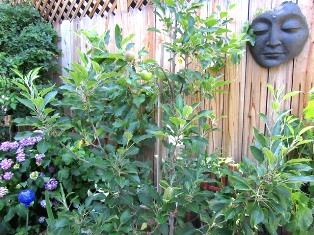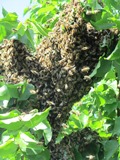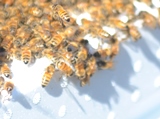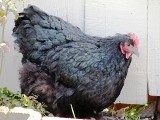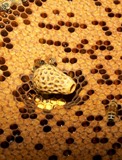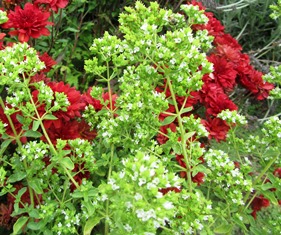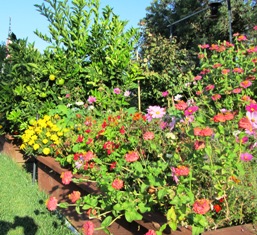Blog Archives
Creating Sacred Space in Tandem with Nature
One of the first things I did after buying the farmette was to create a space to sit, rest, pray, and dream. Basically what I had to work with was an empty field with a tiny farmhouse in the middle. The house was a construction zone–not quiet and peaceful or nourishing to the spirit–so I need to create an outdoor sacred place for my sanity.
On the north/cool side of the house, my husband and I reinforced the fence and then planted some climbing roses, Japanese maples, hydrangeas, calla lilies, and irises. To anchor the space, we added a Cox Orange Pippin apple (a sweet dessert apple first grown at Colnbrook, Buckinghamshire, England, 1825).
Later, when I found the meditation mask, I decided to hang it on the fence, moving in a bench opposite (now my favorite place to read). A brick walkway leads to an arch that supports two Cecile Brunner climbing roses, opulently covered in tiny pink rosettes each spring. A blue reflecting ball offers a soft splash of cool color against the hydrangea pink florets. Finally, we tucked in blue-blooming dwarf agapanthus (Peter Pan) and fuchsia geraniums to give the space lushness and some cool, refreshing color.
There are many such places on our property that I’ve claimed as sacred space, but this one is my favorite. We redid the windows on the house’s north side so that the largest one looks out from our dining/living room onto this garden space. A fountain with soft gurgling water adds to the tranquility.
Besides art and possibly a water feature for your sacred space, you’ll want to think about the plants (tall, mid-size, and small), herbs, trees, climbing vines, and roses. I chose plants that I associate with my grandmother’s garden and the various gardens my mother created.
You don’t need a farmette to create sacred space. Rock gardens and arid landscapes, rooftop gardens, and cityscape corners and alleyways can be transformed as well. Work with the natural setting around you. Just stay in tune with what speaks to your spirit, gives ease to your heart, and restores peace to your mind as you create your sacred space.
Henny Penny Farmer’s Almanac–Sayings
Humans could learn a thing or two from the world of honeybees where all endeavor benefits the entire colony, not an individual bee.
A tea made of meadowsweet, chamomile, or peppermint herbs can calm an upset stomach.
To get stronger egg shells, feed your chickens extra calcium.
Producing manure is easy; it’s the moving of it that takes patience and the right shovel.
Sow above-ground plants during a waxing moon and below-ground plants during a waning moon.
The simplest treatment for a bee sting is to get the stinger out.
Move chickens and bees at night; when they awake in the morning, the move is a fait accompli.
If you enjoy listening to songbirds, it might interest you to know the male is generally the singer since he uses song to attract a mate and defend his territory.
Birds don’t just sing; they call, and their calls are how they communicate
with a partner or sound the alarm that a predator is near.
Box and jug wines are fine as long as you never drink or cook with a flawed wine.
Use a dab of raw honey or bee propolis to treat a peck wound on a chicken as honey and propolis have antiseptic, antibacterial properties.
Each nostril of a dog’s highly sensitive nose can separately track scents—a skill proving useful to humans in finding illegal drugs, locating dead bodies, and even detecting cancer.
Red wine remains drinkable for decades because the tannins act as a natural preservative; however, the wine must be properly bottled and stored.
If you want to lower your cholesterol, decrease your stress level
and improve your blood pressure, adopt a dog.
Pacific oysters can engage in annual sex reversals; male one year, female the next—one of nature’s many surprises.
Help your chickens go through the molting process (when they lose feathers and stop egg production) by feeding them 20 percent more protein and limiting their stressors.
Time spent in a garden is a lot like yoga; it slows the breath, quiets the mind, and lets you get to the truth.
To break your dog’s habit of licking you, get up and go into another room
immediately when the licking starts so the animal will associate its licking with your leaving.
If you don’t want to be devoured by insects, wear light colors when gardening.
If you want to strengthen your immune system, consume a teaspoonful of raw buckwheat honey every day.
A honeybee queens live 10 times longer than her worker bee sisters and while they are sterile, the queen remains reproductive throughout her life.
To keep your bee colony strong and robust, feed your honeybees when their food sources become scarce.
To make a fat-free broth, pour the juices of a roasted chicken or turkey into a wide-mouth jar and refrigerate until solidified; then, skim away the fat that has risen to the top.
You can’t shift the status quo if you don’t take action.
When relationships sour like beans and bitter herbs, an hour in a garden
can generate the sweetness of new dreams.
©November 2013 by Meera Lester
Permission is granted for use of individual quotes, provided the quoted material contains the following credit: “Used with permission from Henny Penny Farmers’ Almanac.”
Don’t Put Away Your Gardening Gloves and Trowel Just Yet

Red pomegranates hang like jewels in contrast to the lush green leaves that will soon turn yellow and drop
Autumn has a arrived. The fruit and nut trees are shedding leaves and preparing for winter dormancy. Pumpkins are taking center stage for harvest festivals and Halloween decorations. Apples have been gathered are are being peeled and cored for pies and cider making.
If you are thinking about putting away your gardening gloves and stashing your trowel and wheelbarrow, hold on a minute. It’s possible to extend the growing season from summer into autumn and even later . . . by taking a few precautions.
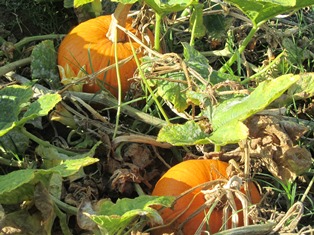
Pumpkins in my garden sport golden shades of orange and yellow, signalling arrival of the cool season
As the sun slants lower in the sky giving us shorter days, less light, and fewer hours to garden, there are some plants that will grow just fine during the cool days of fall.
However, you must select the right plants for the cool season. In addition, you’ll increase your plants’ survival rate by growing them in raised beds and boxes with good soil and aged manure. Wet them well if a cold front comes through (it’s counter-intuitive but moisture will protect their roots). Keep them warm at night with plant covers that you take off during the day when they can make the most of the sun’s warmth and light.
Consider growing some of these cool season crops: beet, bok choy, broccoli, bulb onion, chard, fava bean, garlic, green onion, kale, kohlrabi, lettuce, radish, spinach, and turnip. I’ve found many of these plants available at my local DIY garden center during the past two weeks.
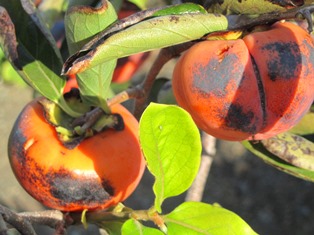
Coffee Cake, a new variety of Fuyu persimmon I’m growing will soon be ripe for picking, slicing, and serving
For November, depending on weather conditions in local microclimates, Northern California gardeners can grow fava bean, garlic, greens, leek, lettuce, onion, pea, radish, and spinach as well as some perennial herbs, especially in boxes and/or pots on the patio or in protected places such as porches.

My pumpkin vines, over 25 feet long, still have numerous blooms and lemon-size green pumpkins hanging on
Because of Northern California’s mild Mediterranean climate, gardeners can enjoy cultivating plants from spring through the fall, not just during our hot summer months. If it gets too chilly for the poor honeybees to pollinate, get yourself a soft watercolor brush and do the pollination yourself.
Finally, it’s worth noting that during our rainy season, the water for the garden falls from the sky rather than from the hose. One of the many reasons not to put away the garden tools just yet.
Plant Culinary Herbs for Yourself and the Honeybees
During my pre-rainstorm walk today around the farmette, I noticed honeybees foraging for nectar in the last blooms of the cosmos, nasturtiums, and rose geraniums.
This is the time of year that the bees search for autumn pollen and find it in the last flowers of a summer garden, but also in the blooms of lavender, heather, thistle, balsam, and eucalyptus.
In the spring, I planted a large pots of culinary herbs on my patio to use in cooking. The mixture of plants included sage, parsley, marjoram, chives, sweet basil, rosemary, English thyme, Greek oregano, Lebanese mint, chocolate mint, lemon bee balm, spearmint, and French tarragon.
If you enjoy using such herbs in autumn and winter soups, teas, or breads, for example, consider planting pots of herbs to grow on the patio or on a shelf in a garden window or on the window sill. The plants will brighten the cooking area on dreary dark days and, with just a snip, add flavor to your culinary creations.
Grow mint in pots if you don’t want it spreading over your yard. The same is true for the Greek oregano and also English thyme and French tarragon–those plants will grow beautifully even though confined in clay pots, old urns, or even half wine barrels.
In early autumn, there is a diminishing amount of nectar (in blooms) available for the bees. This is the known as the nectar gap–when the sources of nectar for the bees are minimal and new sources have not yet appeared. This time of the year to think about planting for yourself and also the honeybees.
Herbs for Healing and Well-Being
For thousands of years, humankind has relied on the healing properties of herbs, plucked in the wild or cultivated in gardens, to treat what has ailed them. Modern holistic practitioners value herbs and plant-based medicines as integral elements in re-balancing the health of their patients and fostering wellness and robust vitality.
Doctors trained in allopathic or mainstream Western medicine traditionally have prescribed chemically based medicines (that usually have side effects). However, Western-trained doctors may also recommend the use of herbs for certain health issues. Always talk with your physician before starting any type of self-treatment with herbs. Keep your physician informed of herbs you may be taking. Herbs or herb formulations can interact or even block the efficacious effect of the medications your doctor has prescribed.
Dr. Andrew Weil, the Harvard-trained physician who pioneered the field of integrative medicine (combining mainstream and alternative medicine) and also wrote several best-selling books, suggests three specific herbs can reduce inflammation in the body–tumeric, ginger, and boswellia. These herbs can be found in specific doses formulated in capsules to make it easy to take the right amount. See, http://www.drweil.com/drw/u/QAA142972/Anti-Inflammatory-Herbs.com.
In traditional Chinese medicine, four herbs play vital roles in achieving a state of well-being. Rosemary stimulates brain alertness, mint aids in digestion, sage supports mental acuity, and parsley protects the eyes. See, http://www.doctoroz.com/blog/mao-shing-ni-lac-dom-phd/4-commonly-used-healing-herbs.
Whether herbs are used dried or fresh, made into a tea, tincture, culinary preparation, or packaged in capsules and other forms, they are often included as part of a larger health-focused program to restore and maintain a balanced, healthy body.
Ayurveda, a healing system used in India since ancient times, utilizes herbs in treatments that can encompass many healing modalities. According to Ayurveda, a balanced, healthy body depends on a strong metabolic and immune system, attained through proper nutrition, exercise, yoga, and meditation (to relieve tension and stress that can accumulate in the body and mind).
Herbs used in Ayurveda are many and include (but are not limited to) andrographis, ashwagandha, black mustard seed, cardamom, coriander, cumin, ginger, purslane (pigweed), tulsi (holy basil), tumeric, and visnaga.
During the medieval period, gardens of priests, convents, and cloisters contained the herbs that members of the clergy as well as ordinary people believed could treat or cure them of their ailments. In the twelfth century, German mystic Saint Hildegard of Bingen wrote about health and healing, detailing medicinal uses of over 200 healing plants.
Although most herbs are fairly easy to grow, take the time to learn about them. Provide for the plant’s needs (water, nutrients, sun or shade requirement). Find out when to harvest and how best to use the plant for your health and well-being. Find out what the negative factors might be in using a specific herb or medicinal plant. When you engage in this type of work, you continue a practice begun thousands of years ago that can have health benefits for you today. But don’t forget to have that discussion with your doctor before taking medicinal herbs.
Boxes To Grow Just about Anything
When we arrived at the Henny Penny Farmette our first summer here, the weeds on the property towered over our heads. We knew it would take a lot of work to change the wild, chaotic landscape into something beautiful. After we pulled more weeds than we ever want to remember, we planted a garden, started a bed of herbs, and (during the following bare root season in late January) put in an orchard. That rainy season we had 21 straight days of rain.
My husband Carlos had left to visit his family in the Dominican Republic. The rains didn’t let up. I feared the septic would overflow, take down the young trees, and destroy our herb beds. Near the end of that rainy period, the water level rose high enough to threaten the door into the house. Then the rain stopped.
When Carlos returned, he hired some workers to help us reconfigure the landscape, move dirt, and create a level backyard. We put in a small lawn and gravel paths that defined the entire space at the back of our property. We also raised one area of the yard where the septic could drain in a different direction than the house if it rained like that again.
Carlos incorporated into the overall landscape design several planting boxes in which to grow our berries as well as flowers. The soil here is heavy clay that turns to concrete in the summer. Planting boxes allows us to control the soil, enriching it with nutrients and compost as needed. The gravel paths enable us to move around the acreage during the rainy season, inspecting the boxes of plants, without getting getting mired in mud. The cost to build each box is about $125.00.
Planting boxes allow us to meet each each plant’s needs, for example, acid-soil for blueberries, or great drainage for roses. I first observed raised beds in massive planting boxes during a trip to Russia in the late 1990s. In a centuries-old village along the Volga, I saw vegetables and herbs flourishing under an apple tree planted in the center of a massive box. Our Henny Penny Farmette planting boxes are 4 ft. by 6 ft., so we wouldn’t grow trees in the boxes. However, we have planted a citrus or fruit tree between the boxes. These raised beds in frames truly make it possible to grow almost anything and create a sense of order out of the wild chaos of nature.
 Facebook
Facebook Goodreads
Goodreads LinkedIn
LinkedIn Meera Lester
Meera Lester Twitter
Twitter



